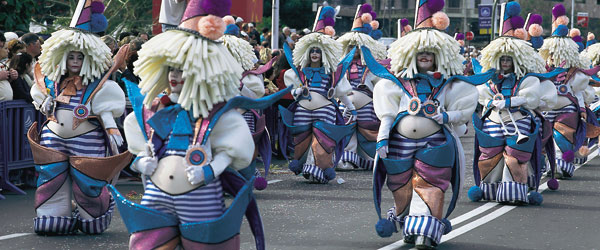Carnival in Santa Cruz de Tenerife and Cadiz
It's not just a stereotype. Spain really is a country where people love fiestas, shared emotions and socialising with each other in public places. Everything from the Fallas bonfire festival in Valencia, the bull-running in the Sanfermines and the Easter week commemorations in Seville... there is an endless list of celebrations that are known all over the world. And the carnival festivities are among the most exciting.
There are very few Spanish towns and villages that do not celebrate the festival of carnival; however two in particular stand out and have achieved international fame for good reason: these are the carnival celebrations in Cadiz and Santa Cruz de Tenerife.
The carnival in Santa Cruz de Tenerife is without a doubt the most Brazilian of all the carnivals held in Spain. For one week the streets of the capital of Tenerife teem with people who have flocked here from all over the world, and the whole city is caught up in a cornucopia of music, colour and fantasy, in an intensely festive atmosphere which has to be experienced to be believed. The island's carnival, which has grown to become one of the largest in the world, is an unrestrained explosion of high spirits and exuberance which perfectly typifies the essence of this universal festivity: for a few days everything is permitted, and the only rule is to let yourself go, cast aside all your inhibitions and constraints and surrender to the complete and total expression of freedom which defines the Carnival of Santa Cruz.
However nothing about this seemingly chaotic pandemonium is improvised or left to chance. For several months the local inhabitants of Tenerife throw themselves wholeheartedly into preparing the floats which are paraded through the streets of the city – creations featuring generous doses of imagination and infectious good humour.
They rehearse the songs and music and compose parodies about current political affairs or celebrities. All the carnival groups take part in the opening parade on the first day (Saturday before carnival): street bands with a distinctly Brazilian feel, the typical carnival choral groups formed by both adults and children, street musicians, choirs and of course thousands and thousands of people all dressed up in their costumes. The carnival queen is selected from among the most beautiful young women, whose attractions are enhanced by the gorgeous dresses designed specially for this important occasion. And carnival Tuesday marks the highlight of the festivities with a special enclosure which brings together all the participants. This is the culmination of everything the Carnival represents for Tenerife: an authentic metamorphosis, a long hiatus in people's everyday routine.
Although the Carnival in Cadiz is in essence the same, and is celebrated with similar exuberance, this version has various original features which give it its own undeniable personality.
Here too there is a long run-up to the festivities, a period of over a month which starts with the "Erizada" or sea urchin festival, a popular feast with this mollusc as the star attraction, followed by a competition of choral groups and the typical carnival street bands held in the Teatro Falla theatre, which is one of the highlights of the carnival celebrations in Cadiz. The various types of typical carnival musical groups all compete in the theatre to create the most original and amusing visual and musical setting for their songs.
Right after this famous competition, the streets erupt with enthusiasm, as though the theatre were the last barrier holding back the excitement. The different groups parade through the streets of the old quarter of the city singing the typical carnival songs, tangos, traditional Spanish songs, medleys and pasodobles that they themselves have composed and which always have an element of cutting political and social satire, or a touch of eroticism, all mixed in with generous doses of typical Andalusian wit and humour. Nothing is off limits. But the festivities are not only the province of these organised groups; the whole city throws itself into the celebrations, and local inhabitants and visitors alike converge in an atmosphere of riotous excitement and colour, in a spirit of complete and total communication. The great parade which takes place on the Sunday known as the "domingo de Piñata" marks the culmination of these spectacularly energetic festivities, and is a night of jubilation in which the collective delirium reaches a height of festive, high-spirited and colourful expression.
Imagination, fantasy, vitality, good humour, but also a civic spirit are the hallmark values of these two Spanish fiestas which are admired and envied all over the world.







